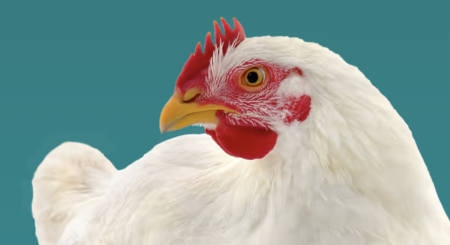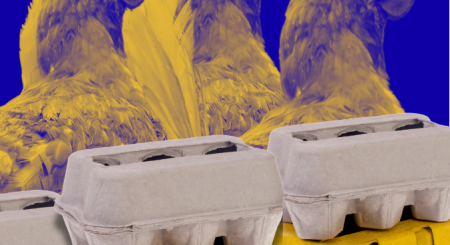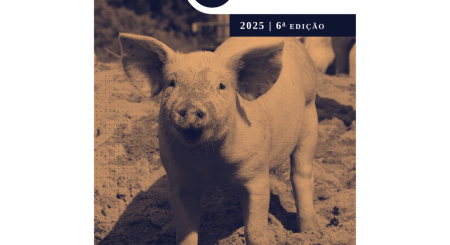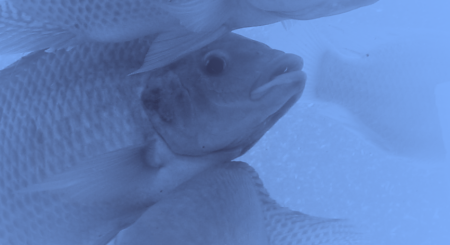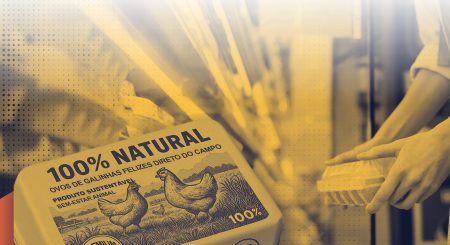We know that the consumption of eggs is a practice present in many cultures around the world, and these foods are well known for their versatility and nutritional value. However, have you ever stopped to reflect on the origin of these eggs and the impact that our consumption can have on the quality of life of the laying hens, responsible for their production?
The way chickens are raised can vary considerably, from more exploratory systems to approaches that prioritize animal welfare. To help you better understand how egg production works, we have prepared this article, answering the most frequently asked questions on the topic.
What are laying hens and how do they live?
Laying hens are those raised with the main purpose of producing eggs. In their natural state, they should live freely to move freely, explore the environment, interact with other birds, perch for rest and protection from predators, be able to build a nest in a quiet and protected place, to lay their eggs peacefully.
But, in the production system, the majority of them (around 90%) live confined in cages stacked inside sheds, with food based on food and antibiotics, without perches, nests and without the possibility of taking a sand/earth bath, Don’t even spread your wings.
Are there different types of laying hen farming?
There are four main systems for raising laying hens: cages, cage-free, free-range and organic.
How does the Cage system work?
Each hen is kept in its own cage, usually smaller than an A4 sheet of paper. This practice greatly limits the birds’ ability to express themselves and perform natural behaviors, such as scratching, perching and bathing in the dirt.
This system is designed to maximize egg production, aiming for high productivity of laying hens. To prevent chickens from being injured or even killed due to the stress of confinement, many breeders choose to cut off part of the birds’ beaks, which is a controversial and cruel practice.
Due to the crowded environment and stressful conditions, chickens in this system may be more prone to illness. Therefore, they are often treated with antibiotics to prevent the spread of infections.
How does the Cage Free system work?
Chickens are raised in sheds or covered areas with enough space to move freely, scratch, roost and bathe in the dust. The number of chickens per square meter is reduced compared to the cage system, providing more individual space for each bird, but still far from ideal.
Cage-free chickens have the opportunity to eat a little more natural food, including grass, insects and seeds in addition to traditional feed. Due to the more favorable and less stressful conditions, antibiotic use is generally reduced in the cage-free system.
Watch the video produced by Alianima here and better understand the differences between the Cage and Cage-Free systems.
How does the Caipira system work?
Free-range chickens are raised in semi-intensive systems. This means they have more space to move around and express natural behaviors compared to cage confinement and cage-free.
In this system, the shed where the chickens are housed has a lower density of birds, generally with up to 7 birds per square meter, and they have access to an outside area during the day, where they can scratch, sunbathe and explore natural environments. This outdoor area usually has up to 2 birds per square meter.
In the free-range system, several breeds of rustic chickens can be mixed, favoring genetic diversity. They can feed on grass, insects and seeds, providing a more varied and natural diet, and the use of antibiotics and medications is reduced or non-existent compared to intensive systems.
How does the Organic system work?
Chickens in the organic system are raised with more rigorous and restrictive principles, ensuring a higher level of animal welfare. The shed where they are housed also has a lower density of birds, generally up to 6 birds per square meter. Similar to free-range chickens, those from organic farming have access to the outside area, but with even more space, 1-3 square meters for each bird.
Chickens have a diet that is at least 80% organic, without the use of pesticides and genetically modified ingredients, and the use of antibiotics and medicines is practically non-existent in the organic system, with a focus on disease prevention through appropriate management practices. They are created in accordance with the standards established by organic certifications, ensuring compliance with sustainable and animal welfare practices.
Watch the video produced by Alianima here and discover the differences and benefits of Free-Range and Organic Chicken systems.
Is it possible to identify the type of chicken farming just by looking at the eggs in the supermarket?
No, it is a myth to believe that it is possible to identify the type of chicken farming just by the color of the egg shell or yolk. The color of the shell is determined by the chicken’s lineage and the color of the yolk can vary depending on the diet, but can be altered artificially.
Watch the video produced by Alianima here , where we demystify this belief and tell you the difference between the colors of eggs.
How to choose eggs from chickens raised in less exploitative conditions?
To choose eggs from chickens raised in less exploratory conditions, it is important to observe the egg packaging and look for information about the chicken farming system. Free-range and organic farms are generally raised in more satisfactory conditions and have access to outdoor areas.
To ensure that egg consumption is more respectful of the hens’ needs, it is important to look for information on the egg packaging about the poultry farming system. Organic certifications can also be a positive indicator.
How can I do my part as a consumer?
Some organizations have been talking to the industry to show cruel practices against animals that need to be banned. As a result, large supermarkets have committed to removing eggs from hens confined in cages from their shelves by 2028. And companies in the food industry have also committed to no longer using these cage-free eggs in their products.
For a conscious consumption of eggs, it is important to choose eggs from systems that take the birds’ needs into account, such as free-range and organic systems.
Access here the report of companies committed to no longer using eggs from chickens raised in cruel and precarious cage conditions. On your next trip to the supermarket, take the list of companies and information with you. Together, we will be able to combat animal and environmental exploitation.


